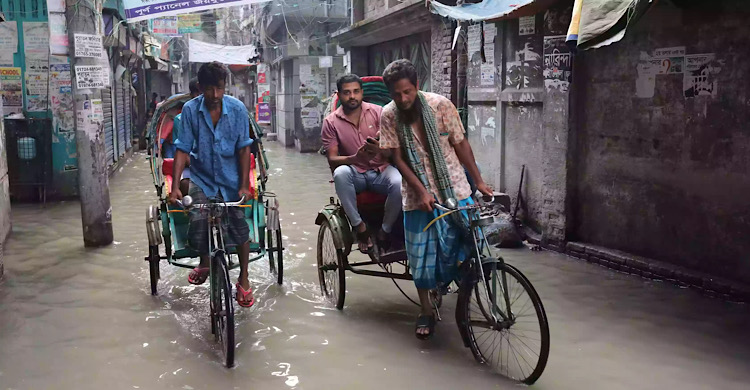Monsoon Misery Looms: Dhaka braces for worsening waterlogging crisis


Already grappling with multiple problems like traffic congestion, mosquito infestations and pollution, Dhaka’s residents are now bracing for yet another challenge—waterlogging—as the monsoon approaches.
Despite numerous projects undertaken over the years efforts have largely failed to deliver the desired relief from this persistent problem and experts have warned that this year the situation could be worse than before.
In recent weeks even brief spells of rain have submerged several areas in the capital, halting traffic, flooding roads and lanes and exposing the fragile state of the city’s drainage system.
Despite repeated assurances and spending of crores of taka by the two city corporations, the problem shows no sign of abating, leaving residents frustrated and fearful of another season of waterlogged.
It has become a growing challenge for residents, severely impacting daily life and leading to a range of negative social, physical and economic effects.
It disrupts routine activities, causes severe traffic congestion and damages infrastructure, particularly in low-lying homes, educational institutions, shops and commercial establishments.
Expensive Efforts, Minimal Results
According to official sources, a large amount of money has been spent over the past 17 years by Dhaka Wasa and city Corporations to address waterlogging.
Dhaka WASA initially held responsibility for drainage infrastructure, including 385 km of major pipelines and 26 canals.
In late 2020, the government transferred this responsibility to the two city corporations along with control over all canals and drains.
Since then, both the Dhaka North City Corporation (DNCC) and Dhaka South City Corporation (DSCC) have each spent crores on infrastructure, cleaning drives, and new equipment.
In 2023–24 fiscal year alone, DSCC allocated Tk 90 crore directly to waterlogging mitigation with an additional Tk 30 crore for cleaning operations, Tk 2 crore for restoring canals and ponds, and Tk 1 crore for purchasing water pumps.
Besides, DNCC earmarked Tk 25 crore for modernising pump house equipment, Tk 38 crore for canal development and tree plantation and around Tk 25 crore more for cleaning, repair and maintenance of canals, culverts, and lakes.
But the ground reality tells a different story.
The capital continues to reel under the pressure of monsoon waterlogging, with many questioning the effectiveness of these expenditures.
Waterlogging Hotspots
Despite these efforts, the waterlogging problem in Rampura, Malibagh, Mouchak, New Market, Azimpur, Nilkhet, Bakshibazar, Sayedabad, Shonir Akhra, Old Dhaka, Dhanmondi, Mirpur, Shewrapara, Motijheel, Banani, Khilkhet, Uttara, Karwan Bazar, Bijoy Sarani, Agargaon, Mohammadpur, Merul Badda, Vatara, Kuril, Bashundhara and parts of Gulshan and Hatirjheel remained unchanged.
According to city corporations ‘officials, the same areas are expected to face worse waterlogging again this year.
In the north, waterlogging is likely in areas like Badda, Vatara, Tejgaon, Kuril, Bashundhara and around the airport road.
In the south, Khilgaon, Mugda, Jurain, Rajarbagh, New Market and parts of Motijheel and the Secretariat area are on the list.
Reasons Behind Waterlogging
Urban planners and experts point to several deep-rooted issues behind Dhaka waterlogging.
Those areas have unplanned urbanisation, canal encroachment, poor drainage infrastructure and lack of waste management.
Polythene bags, plastic wrappers, and food packaging often block drains in the capital, further aggravating the problem.
Dr Adil Muhammad Khan, professor of Urban and Regional Planning at Jahangirnagar University, said Dhaka's waterlogging issue requires urgent short-, mid- and long-term strategies.
“Corporations no longer have the luxury of shifting blame. The solution lies in strong planning and strict implementation,” he said.
River and Delta Research Centre (RDRC), a non-government research organization, has recently conducted a study that identifies nine waterlogging-prone areas in the capital and offer solutions to the ongoing problem.
The study titled ‘Waterlogging in Dhaka city and our encroached canals’ was conducted in July, 2024.
The canals recommended for excavation include Rupnagar Main Khal, Baunia Khal, Baishteki Khal, Sangbadik Colony Khal, Kalyanpur Khal, Ibrahimpur Khal, Panthapath Box Culvert Khal, Rayerbazar Khal, Jirani Khal, the south end of Rampura Khal, Dolai Khal, Kadamtali Khal and Manda Khal.
The study identified nine waterlogging hotspots: Pallabi Shiyalbari, Rupnagar, and Eastern Housing; Kalshi and Mirpur 11; Tolarbag, Ahmed Nagar and Paikpara; Shewrapara, Kazipara, and Kafrul; Kolabagan, Dhanmondi 27, Kathalbagan, Green Road and Hatirpool; Hazaribagh, Nawabganj, Rayerbazar, West Dhanmondi, and Dhaka Newmarket; Rampura and Badda; Sutrapur, Wari, Nawabpur, Kazi Alauddin Road, Siddique Bazar, Narinda and Tanti Bazar; and Jurain, Siddhirganj, Zaker Manjil, Shyampur, Purba Jurain, Saddam Market and Rayerbagh.
